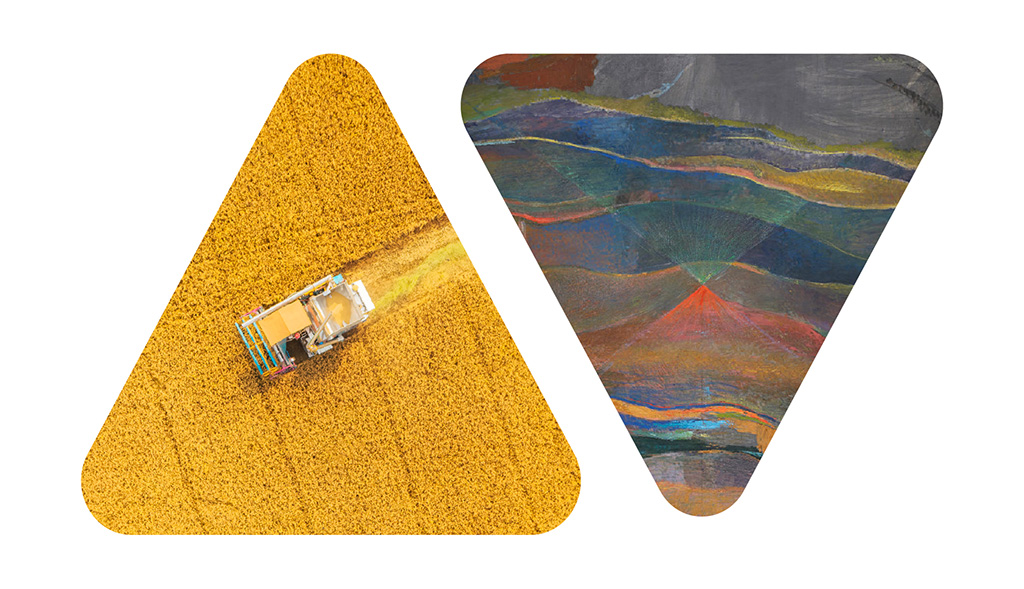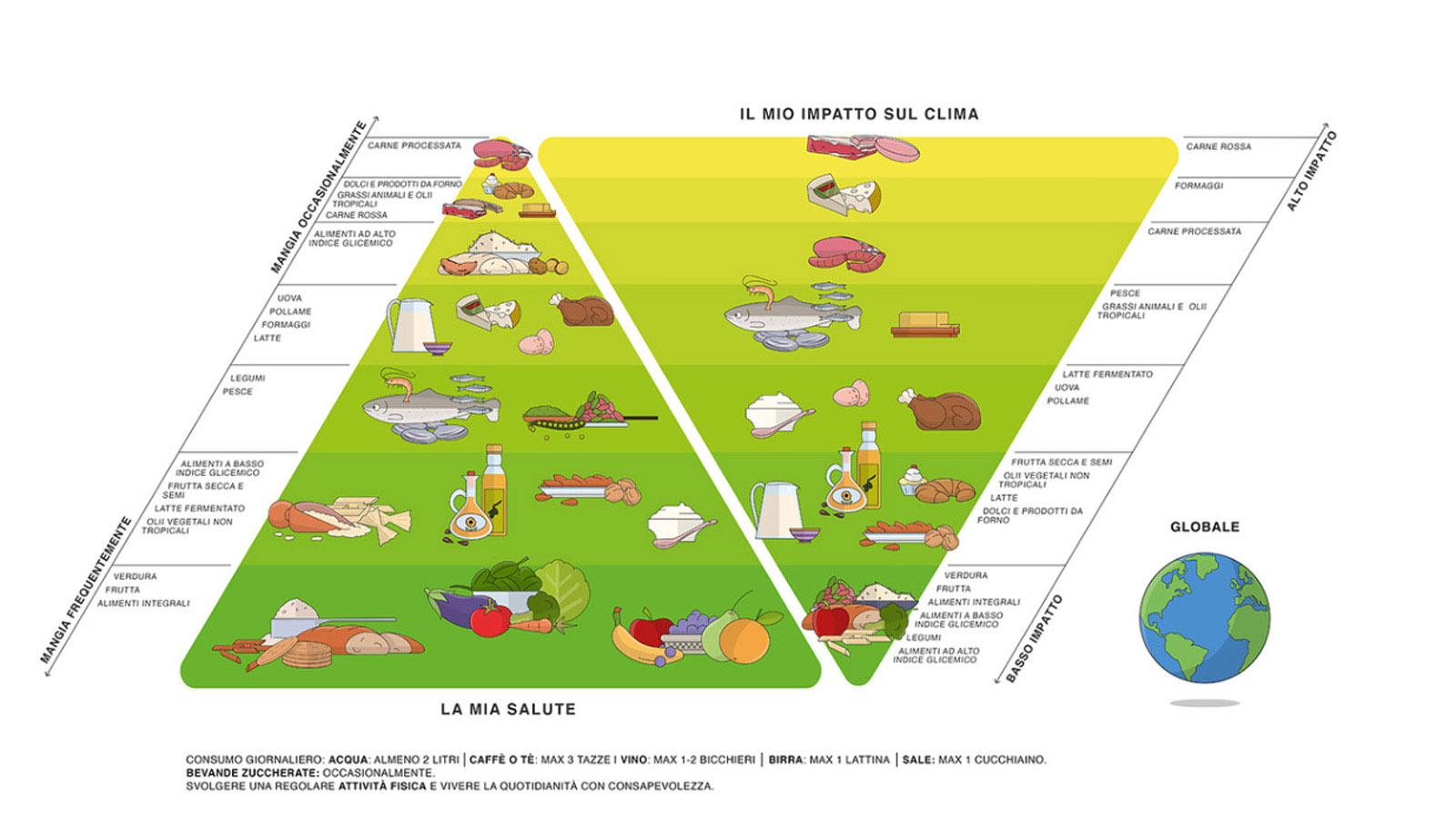
Research
DOUBLE
PYRAMID
CONNECTING
FOOD CULTURE,
HEALTH & THE CLIMATE

THE DOUBLE PYRAMID OF HEALTH & THE CLIMATE
Alongside the Health & Climate Pyramid, the Double Pyramid is a straightforward and direct way of communicating the characteristics of a balanced, healthy and sustainable diet. This model aims to encourage the adoption of eating habits that are both healthy for humans and respectful of the planet, reducing the impact of food choices on the environment and climate change.
On the basis of the most recent evidence in the field of food, health, and the environment, Barilla Foundation has updated the Double Pyramid model, in conjunction with the University of Naples Federico II.

THE HEALTH PYRAMID
The Health Pyramid sorts foods into 18 food groups in seven levels, according to the recommended frequency of consumption to maintain people’s health. At the base, the foods that should be consumed most often: fruits, vegetables and whole grains, followed by dried fruits and seeds, non-tropical vegetable oils, refined cereals with a low glycemic index, and yogurt and other forms of fermented dairy produce. After that, pulses and fish – the preferred sources of protein, followed by poultry, eggs, milk and cheese. The next step up includes refined cereals with a high glycemic index, and to finish, red meat, animal fats and tropical oils, sweets and bakery products. Processed meats come at the top, to note that they should be consumed in moderation.
THE CLIMATE PYRAMID
The Climate Pyramid shows how products of animal origin contribute the most to climate change, compared to plant-based products and their lower impact on the environment.
The Climate Pyramid is based on the Su-Eatable Life project database and its classification of various foods based on their carbon footprint. Foods that should be consumed more often to keep us healthy generally also have a lower impact on the climate.
HOW TO MAKE A DIFFERENCE WITHOUT GIVING ANYTHING UP
By adopting a varied and balanced diet we can promote our health while reducing our contribution to climate change. It’s OK to eat anything; the important thing is to consume the right amount of different foods and how often to do so, and to consider a higher proportion of plant-based food groups such as fruit, vegetables and whole grains.
FOODS IN THE DOUBLE PYRAMID
The Double Pyramid provides recommendations for how often to eat every food group and shows the relative impact of each one on health and the climate.
Specifically, the Health Pyramid categorizes foods into 18 groups (according to impact on the risk of developing cardiovascular disease, animal or plant origin, and nutritional characteristics), and divides them into seven levels based on the recommended frequency of consumption.
The base of the pyramid includes the food groups associated with the highest benefit in terms of protection from cardiovascular diseases and on health more generally: fruit, vegetables and whole grains. Two daily portions of each are recommended.
The second level covers food groups that should be consumed regularly, but not more than one portion per day each: foods based on refined cereals with a low glycemic index, such as pasta, parboiled rice or barley, as well as nuts, fermented dairy produce such as yogurt, and non-tropical vegetable oils, including olive, maize and sunflower oils.
Next up, foods such as pulses and fish, associated with a reduced risk of cardiovascular disease, three or four servings of which should be consumed per week.
The fourth layer includes foods such as poultry, eggs, cheese and milk, the intake of which has neither a positive nor a negative impact on the risk of developing cardiovascular diseases if they are consumed in moderation (no more than three portions per week).
The fifth step up consists of foods with a high glycemic index, such as white bread, refined rice, potatoes and other tubers. No more than two servings of this food should be eaten per week.
Animal fats such as butter, tropical oils such as palm oil, red meat and sweets, and baked goods, made from refined flour and sugar, are located in the sixth level of the pyramid, given that consuming them is associated with a significantly increased risk of cardiovascular events. The advice is to eat these no more than once a week.
The pyramid is topped off by processed meats (sausages, bacon, salami, ham and other encased meats), associated with a high risk of cardiovascular disease and other chronic diseases. These should only be consumed occasionally. For the Climate Pyramid, median carbon footprint was calculated for each food group. The 18 values produced by this calculation, one for each food group, were clustered to define the levels of this second Pyramid.
THE SEVEN CULTURAL DOUBLE PYRAMIDS
Barilla Foundation decided to adapt the Double Pyramid to different food cultures, to foster greater awareness of healthy and sustainable diets in different geographical regions: Nordic countries and Canada; USA; South Asia; East Asia; Africa; Latin America; Mediterranean countries.
Each Pyramid was paired with an example recipe, with the intention of celebrating the value of global diversity. Each recipe combines foods for a healthy diet; foods with low impact on the climate in terms of CO2 emissions; foods representative of a specific geographical region, culture and tradition.
By exploring the ingredients of each food tradition, and by immersing ourselves in the flavors, colors and aromas of typical dishes, food can take us on a genuine trip round the world, to discover how every culture can offer a healthy, sustainable diet
Food and environmental sustainability
HELP US DISSEMINATE THE DOUBLE PYRAMID
The value of the Double Pyramid of Health and the Climate is twofold: on the one hand, it represents an excellent synthesis of key takeaways from medicine, and from studies on food and the impact our choices can have on the Planet; on the other, it is a powerful tool for consumer education courtesy of its simple, intuitive graphics. You too can contribute to the dissemination of the Double Pyramid of Health and the Climate, and find out more about the recommendations for a healthy, sustainable diet. Download, use and share the infographics provided here. If you intend to reproduce them by any means, please complete the form to request authorization by stating the intended use.
FILL OUT THE FORM TO DOWNLOAD THE DOCUMENTS
Provide us with your personal data and the purposes for which you intend to use the Double Pyramid materials, but please remember to comply with the conditions of use specified.
- The infographics are the property of the Barilla Foundation, and their reproduction must always be accompanied by the wording “Source: Barilla Foundation 2021”;
- Any changes to and/or reworking of the infographics are prohibited.
- Usage of the infographics is limited to contexts related to food, health, and environmental sustainability. Other purposes are not permitted.
